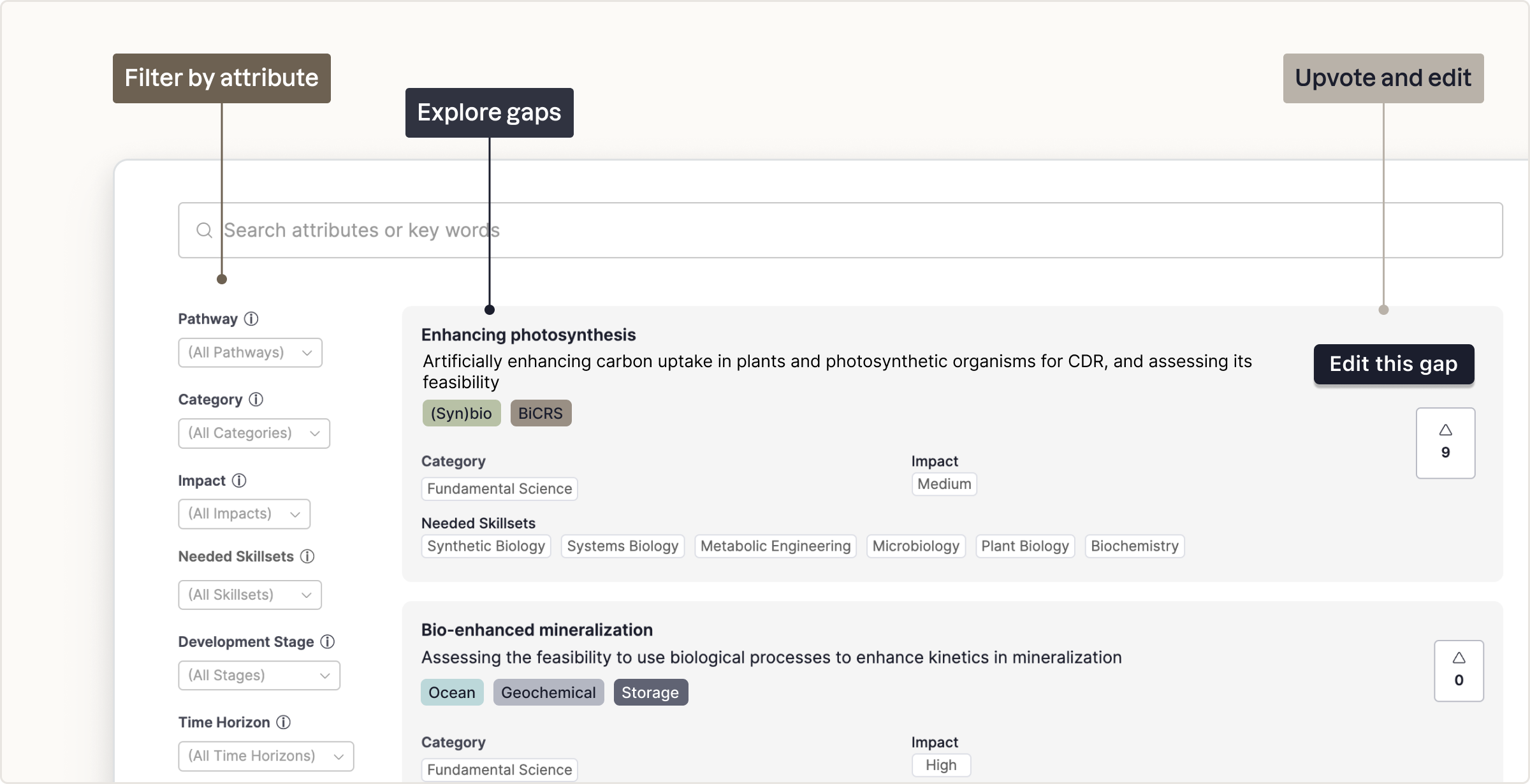Carbon removal knowledge gaps
November 17, 2022|Frauke Kracke, Joanna Klitzke, Nan Ransohoff
November 17, 2022|Frauke Kracke, Joanna Klitzke, Nan Ransohoff
To maximize the chance that carbon removal (CDR) gets to climate-relevant scale, we need to quickly get the most promising ideas to the starting line and then help the best ones scale. Frontier’s approach to date can be best characterized as a demand “pull”—a technology-neutral signal to entrepreneurs and researchers that there is a market for what they’re building. While still early days, we’re seeing leading indicators that the demand signal is working.
At the same time, we’ve noticed a few areas that are underexplored relative to their potential. So, here we’re experimenting with a supply “push.” Our hypothesis is that we can more quickly shake the proverbial tree for the most promising ideas in CDR if we:
We built a CDR gap database that highlights major knowledge and innovation gaps across the field. To make the initial list of 100+ gaps navigable, each one is tagged with attributes to help orient a user to the gap, how impactful it would be if filled, and who might be best positioned to fill it.

If, for example, you are a microbiologist curious about carbon removal, you can filter to see gaps that list "microbiology" as a needed skillset—such as bio-enhanced rock weathering, biomimetic DAC pathways, or microalgae cultivation.
This initial version of the gap database is a collaboration between Frontier, RMI’s Carbon Removal Initiative, academics, carbon removal suppliers, and philanthropies. We want this to be an open-source project that improves over time, and encourage you to help make it better.
Others in the space—RMI, Ocean Visions, Mission Innovation, Innovation for Cool Earth Forum, and numerous academic labs—are working to publish valuable research agendas and roadmaps that detail the timing, funding, and participation required to accelerate individual carbon removal pathways.
This is not intended to be comprehensive, but rather a directional tool to help quickly surface high-impact, open questions that need attention. We narrowed in on five gap categories: (1) fundamental and (2) technical questions, (3) underexplored and novel approaches, (4) MRV-related gaps, and (5) governance needs. But there are a number of other barriers to reaching CDR at scale, like supply chain bottlenecks, insufficient demand, or lower cost financing access that this view doesn’t yet cover.
We encourage you to click around to explore this tool, but below are a few suggestions for how to begin.
We filtered the database by key gap attributes to create “views” based on specific needs. Start with one of the pre-made views below or make your own.
For CDR-curious scientists or researchers
Explore questions in need of early research and lab studies under the Fundamental category. Then, look out for gaps in Conceptual or Lab-scale development stages or where Academia is highlighted as a leading contributor.
For philanthropists looking for areas to fund
Try zooming in on gaps that are High on impact but tougher to solve with Medium to Long time horizons, or where Philanthropy is highlighted in the contributor column.
For CDR veterans or those deep in the space
Narrow in on your area of expertise using the Pathway filter, find potential collaborators under Key Experts, and contribute progress, updates, or suggestions here.
For policy makers looking to tackle cross-cutting system issues
Filter for gaps related to Governance challenges.
A wide range of functions and expertise are needed to tackle these gaps:
This database is a starting point that will evolve as we answer some questions and identify new ones. If you are active in CDR research, please use the links below to surface gaps you are facing and crowdsource and mobilize help:
Each major pathway has an owner who will incorporate edits on a regular basis:
Thank you to Daniel Pike and Cara Maesano from RMI’s CDR Initiative team for their deep partnership in shaping the content and direction of this gap database.
We are also grateful to the more than 30 independent scientists, CDR companies, funders, and other ecosystem actors whose expertise and input helped develop the database content, and particularly to the pathway owners who shaped this content and are committed to making sure this tool remains a relevant, updated reflection of pathway knowledge gaps.
Lastly, thank you to the current and future CDR problem-solvers who are working to address the gaps in this database. We’re inspired by this community’s relentless focus on getting us closer to durable carbon removal at scale.
Questions? Interested in collaborating on these problems? Email us at info@frontierclimate.com